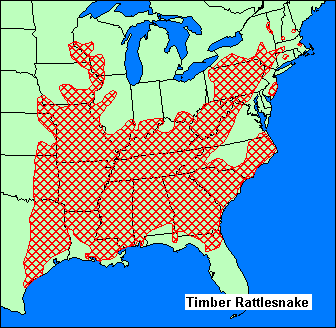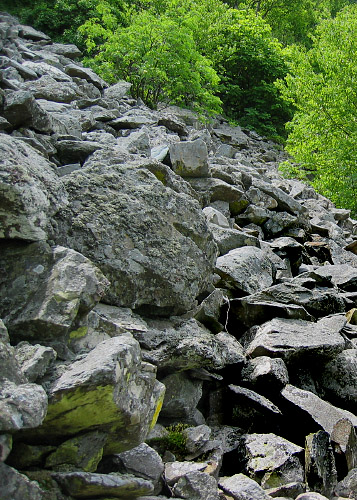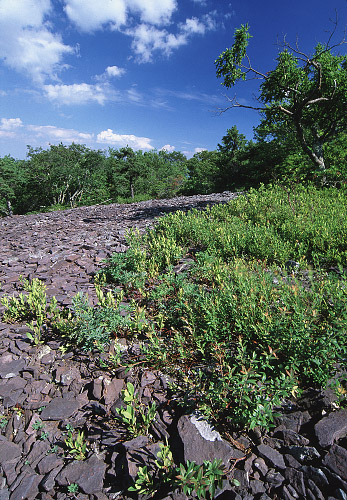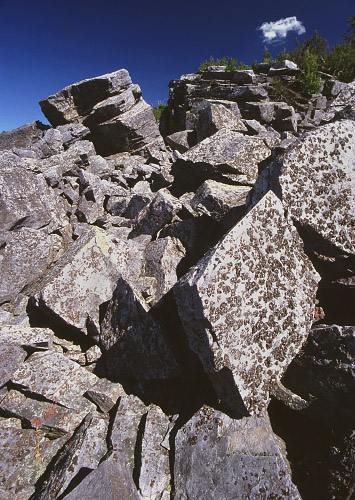Habitat and Geography
Crotalus horridus can be found in almost every state
across the eastern half of the United States. From
eastern Texas all the way north to southern New Hampshire, this
creature has a tremendous range. However, populations within this
vast range are scant
and are continuing to diminish at rapid rates due to habitat
encroachment. Though the majority of the C. horridus species is
located in the southeastern regions of the U.S., this rattlesnake
hits close to home for those individuals living in Minnesota,
Iowa, and Wisconsin, especially along the Mississippi River.
Another common rattlesnake found in this particular area is the
Eastern
Massasauga Rattlesnake.
The timber rattlesnake is also present in many northeastern states, including Ohio
and Pennsylvania and all the way north into New Hampshire and parts
of New Jersey. Below is a map of the US displaying the
numerous areas where you can find C. horridus :
Many environmental and developmental factors influence the types of habitats
that C. horridus resides in. Some of these factors include gravidity
(pregnancy)
of the females, the time or season of the year, and the presence of other
organisms within the area that aid in their survival, whether it be prey
items or trees that provide shade and shelter. The main determinant in
finding a suitable habitat is one that can support ectothermic populations
of terrestrial animals, like C. horridus. Since C.
horridus is "cold-blooded" or ectothermic, it does not have the ability
to regulate its own body temperature. Therefore, it must find a home
that provides the appropriate temperatures necessary to survive. For
the most part,
timber rattlesnakes choose their home based on the time of year and the
current weather.
During the summer, when the weather is obviously much warmer, timber
rattlesnakes prefer to find homes in moist, lowland forests and hilly woodlands or thickets, typically near accessible water sources, such
as rivers, lakes, ponds, streams and swamps. These forested habitats
are usually more than 50% canopy and over 75% vegetative ground
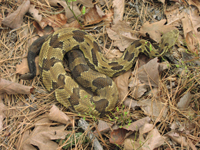 cover.
This vegetative ground cover is important in keeping the rattlesnakes cool
by providing shelter and refuge from the sun on hot summer days and includes eroding
root systems, shrubs, grasses, decaying logs, tree stumps, branches, and leaf litter that has
fallen from the deciduous trees surrounding them. The trees
themselves provide a large percentage of the shade needed to keep their body
temperatures at a low level in the hot heat. Though these barriers from the sun are
cover.
This vegetative ground cover is important in keeping the rattlesnakes cool
by providing shelter and refuge from the sun on hot summer days and includes eroding
root systems, shrubs, grasses, decaying logs, tree stumps, branches, and leaf litter that has
fallen from the deciduous trees surrounding them. The trees
themselves provide a large percentage of the shade needed to keep their body
temperatures at a low level in the hot heat. Though these barriers from the sun are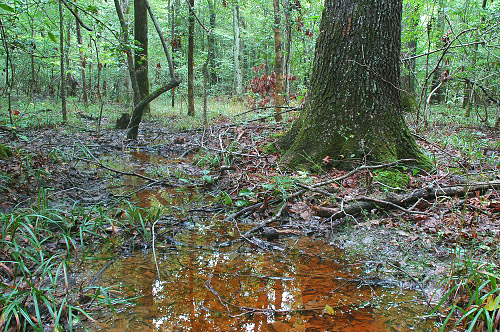 necessary when the weather is too warm, many of the snakes actually take
advantage of the nice weather and spend a lot of time basking in sunny open
areas surrounded by their typical forested habitat. This combination
of forest and open field lands ensures the fact that they can stay warm in
the sun while still being able to keep cool under the shade of a tree.
In fact, during the summer, gravid females prefer to
remain in open canopy bluff-prairies in order to keep their body
temperatures high, but if they become too overheated, they do have the
option to resort back to the various structures that provide shade, such as
brush, trees and rock shelves. Generally, gravid females
prefer 25% canopy cover and equal amounts of vegetation. Adult males and non-gravid females,
however, prefer to be cooler most of the time, hence they stay in areas
closer to forest and woodland edges.
necessary when the weather is too warm, many of the snakes actually take
advantage of the nice weather and spend a lot of time basking in sunny open
areas surrounded by their typical forested habitat. This combination
of forest and open field lands ensures the fact that they can stay warm in
the sun while still being able to keep cool under the shade of a tree.
In fact, during the summer, gravid females prefer to
remain in open canopy bluff-prairies in order to keep their body
temperatures high, but if they become too overheated, they do have the
option to resort back to the various structures that provide shade, such as
brush, trees and rock shelves. Generally, gravid females
prefer 25% canopy cover and equal amounts of vegetation. Adult males and non-gravid females,
however, prefer to be cooler most of the time, hence they stay in areas
closer to forest and woodland edges.
 Though the majority of timber rattlesnakes reside in regions of lower
altitude, several populations have been found living along rocky ridges and
upland woods in mountainous areas. In fact, they have been known to occupy
elevations of up to 6000 feet in upland hardwood, mixed pine-hardwood, and
hemlock forests. These hardwood forests consist of trees such as the
Sugar (Hard) Maple,
Eastern Cottonwood, and the
Silver (Soft) Maple. All are important to the timber
rattlesnake's habit because they provide enough foliage for proper shading. Like that on ground level, the forest and open area
buffer system still proves to be beneficial for these organisms even in
these higher altitude habitats. Instead
of open sunny fields, however, timber rattlers are found along sunny, rocky outcroppings, slopes, ledges, and road cuts, as well as steep bluffs.
As long as they still have access to both sun and shade in order to moderate
their body temperature, altitude isn't a large factor in determining
habitat.
Though the majority of timber rattlesnakes reside in regions of lower
altitude, several populations have been found living along rocky ridges and
upland woods in mountainous areas. In fact, they have been known to occupy
elevations of up to 6000 feet in upland hardwood, mixed pine-hardwood, and
hemlock forests. These hardwood forests consist of trees such as the
Sugar (Hard) Maple,
Eastern Cottonwood, and the
Silver (Soft) Maple. All are important to the timber
rattlesnake's habit because they provide enough foliage for proper shading. Like that on ground level, the forest and open area
buffer system still proves to be beneficial for these organisms even in
these higher altitude habitats. Instead
of open sunny fields, however, timber rattlers are found along sunny, rocky outcroppings, slopes, ledges, and road cuts, as well as steep bluffs.
As long as they still have access to both sun and shade in order to moderate
their body temperature, altitude isn't a large factor in determining
habitat.
When winter begins to set
in and temperatures start to decrease, timber rattlesnakes will return
to their same hibernation den, year after
year, much like how bears do to keep warm during the cold winter months.
Typically, timber rattlesnakes choose to hibernate in dens that run along
mountainous terrain, but many will settle in dens located in pineland
habitats near cedar swamps and stream banks. Along these rocky ridges,
timber rattlesnakes will seek refuge below the frost line, such as large
cracks in rock outcroppings, fissures in a ledge, fallen rock partially
covered by soil, underground cavities, and crevices of dark caves.
Some will even travel far into the sid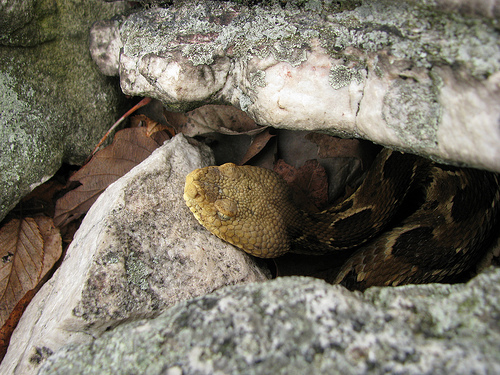 es of steep bluffs or settle
comfortably in the burrows of other animals. Either way, these well
sheltered areas are necessary for the rattlesnake to stay sufficiently warm
and protected from the snow and bitter cold temperatures of winter. On
warm days during hibernation, timber rattlesnakes may emerge temporarily to
bask in the sun, but will then quickly return as temperatures begin to drop
and nighttime sets in. Lastly, timber rattlesnakes tend to hibernate in
communal dens that provide a home for dozens of other related individuals,
as well as many other species of snakes in general. As spring nears, and temperatures begin to rise once
more, snakes
of all kinds will start to emerge from their dens and travel to their usual
summer habitats. Generally, timber rattlesnakes are the last to emerge
from their dens in the spring and the first to retreat to them in the fall.
es of steep bluffs or settle
comfortably in the burrows of other animals. Either way, these well
sheltered areas are necessary for the rattlesnake to stay sufficiently warm
and protected from the snow and bitter cold temperatures of winter. On
warm days during hibernation, timber rattlesnakes may emerge temporarily to
bask in the sun, but will then quickly return as temperatures begin to drop
and nighttime sets in. Lastly, timber rattlesnakes tend to hibernate in
communal dens that provide a home for dozens of other related individuals,
as well as many other species of snakes in general. As spring nears, and temperatures begin to rise once
more, snakes
of all kinds will start to emerge from their dens and travel to their usual
summer habitats. Generally, timber rattlesnakes are the last to emerge
from their dens in the spring and the first to retreat to them in the fall.
Back to Home Page
To learn more about the Adaptations of this organism, click
here
